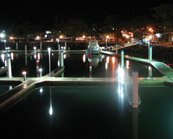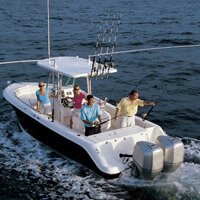In my mind, self-sufficiency represents the single greatest character trait missing from the general American populace today. Society lives with the attitude that if they screw up somehow, someone will come rescue them, so why worry?
Most people passionate about traveling offshore don’t suffer from this self-reliance flaw. They plan. They execute. They return safely. They live to head offshore another day. The U.S. Coast Guard motto, Semper Paratus (Always Ready), applies to every boater, not just the Coast Guard. And not only does being ready mean having all the likely spares aboard that you might need, it also means having the tools to swap them out and the knowledge of how to do it. Here are the most common solutions boaters are likely to face.
• Bent/Broken Prop
If you have two engines on your transom, you can always limp back on one. If you sport a single, you’d better have a spare prop, an extra hub kit and a prop wrench. Actually, it’s always better to have a spare wheel for each engine — remembering of course that counter-rotating engines use different propellers. And one other item: You should probably also carry a diving mask, snorkel and fins aboard. (Be sure to tie to your wrist any tools you use in the water.) This can often make changing a propeller easier on an outboard, and even remotely possible on inboard vessels. The latter will also require a gear puller. If you can make it home at all on an inboard boat with damaged props, do so. Changing such props at sea can be difficult and very dangerous in any kind of waves.
• Fouled Fuel Filter
If you haven’t experienced this problem, you haven’t been boating for very long. Especially in today’s petrochemical world of ethanol-enhanced fuel, clogged fuel filters are commonplace. Steve Lee, global brand manager for large outboards for Mercury, says you can either remove the filter and clear as much water and detritus as you can or simply replace the filter if you have the spare. Spares are cheap ($30 to $35), and you should have at least one or two for each engine.
• Water Pump Not Working
For livewells and washdowns, it behooves you to carry a complete spare pump. Changing out a water pump on an outboard offshore means dropping the gear case, so don’t plan on doing that. Fortunately, water pumps on outboards represent one of the items least likely to fail.
If you run an inboard boat, be sure to have spare impellers and grease for each pump aboard. Changing an impeller is not that difficult. Simply remove the flat plate covering the impeller, carefully remove the split ring from the shaft and use pliers to pry the impeller (and pieces of it) from the pump. Remember which way the rubber impeller blades bent in the housing. Grease up the new impeller, and while bending the rubber blades in the same direction as the ones you removed, slide the new piece into place. Replace the split ring, make sure the gasket is still usable or replace it, and screw the plate back in place.
• Electronics Down
Many recreational boat owners honestly don’t know how to navigate (I don’t mean you personally of course — those other guys). However, they can and do know how to place the cursor of their electronic chart plotter on their desired destination and click "Go To." And since they don’t know about set and drift, setting up a crab angle and the like, as their steering director continues telling them they are drifting off course, they simply hit "Go To" again and again. Do they eventually get to their destination? Sure, albeit via the great circle route, but they get there. Taking an online course on how to actually navigate would be a real benefit. Short of that, knowing where you are at any given moment will allow you always to have a general idea of a compass course home and how far home actually might be from you. Of course, a simple and inexpensive handheld GPS solves the problem instantly. Add to that a waterproof handheld VHF and a personal locator beacon, and you will never need to worry about faulty electronics.
• Engine Not Running
Again, if you have two (or more) engines, this shouldn’t pose too great an inconvenience. Simply head back home at a slower speed. I carry a prop for each engine that is two inches lower in pitch. If I actually lose one of my engines, that smaller pitch lets me spool up and get on plane more easily and run home on one engine at something closer to normal cruising speed.
Single-engine vessel owners face different decisions. Those two decisions include: (1) Fix it and get it running again; or (2) call for a tow. And since the Coast Guard no longer gives free towing assistance in nonemergency situations, there’s no excuse for anyone to be offshore without a subscription to Towboat US (www.towboatus.com) or Sea Tow (www.seatow.com).
Troubleshooting for No. 1 should follow a logical path. It takes several ingredients for an engine to function: fuel, air, spark. Subtract any one of these and your engine stops. When troubleshooting, start at one end of a system and work your way to the other end. For example, if you think your problem is fuel, start with the fuel filter. If that’s clear, continue to check the path to the engine from the fuel tank to see where the blockage has occurred. Diagnosing air and spark issues can be handled similarly.
• Trailer Issues
Many anglers trailer their boats, and the trailer itself can often be the weak link. Brakes and bearings can corrode and fail. Tires can degrade and fail from naught more than sitting idle in the sunlight. Connections and bulbs in lights that submerge each time you launch and retrieve your precious cargo can fail. The tension put on your winch cable can cause the cable to snap — always at the most inopportune moment. Frequent inspection and preventive main-tenance can help you avoid most of these problems.
Suggested Spares and Spanners Stockpile
I suggest that you keep a written inventory of your spare parts, noting where on board you have stored them.
Owner’s manuals
• Waterproof flashlights with spare batteries
• Spare horn(s)
• Spare propeller for each engine
• Replacement bulbs for running lights
• Fuel filters (several in case you have a serious contamination problem)
• Oil filters
• Water-pump impellers and gaskets (with gasket cement)
• Engine oil and lower-unit lube (if applicable)
• Fan belts (if applicable)
• Coolant
• Zinc pencil anodes for engines
• Tapes (electrical, duct, Teflon)
• Hose clamps
• Injectors for half the number of cylinders (diesel inboards)
• Spare alternator and starter (inboards)
• Hydraulic fluid, spare hoses and funnel
• Spare transom plug (if applicable)
• Enough nonspoilable food and water for two days
Electrical Tools
• Ohmmeter, wire cutters, electrical tape, selection of connectors with crimping tool, battery-powered soldering iron and solder
• Handheld GPS, VHF, PLB
Mechanical Tools
• Some Neanderthals believe men are born with knowledge of what should be in a comprehensive tool kit. If you weren’t, the kit should include: pliers, vise grips, screwdrivers (flat and Phillips) wrenches, hammers (rubber and metal) hacksaw, serrated-edge knife, snap-ring pliers, duct tape, WD-40, cordless electric drill with bits.
Trailer Parts
• Bearing grease with Zerk gun, set of new bearings for each wheel, spare lightbulbs, flasher relay, towing ball with lock washer and pin, spare tire, jack and tire iron, bungee cords, flares.


